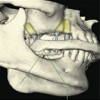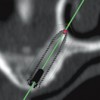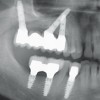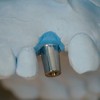One of the most difficult challenges in prosthodontics is the fabrication of complete denture opposing a dentate arch. The principle challenge is to develop bilateral balanced occlusion because if the denture tips and moves during function and particularly during parafunction rapid bone loss ensues. In the maxilla this will inevitably lead to combination syndrome. Occlusal discrepancies secondary to tipped, worn and misshapen teeth and suprer-eruption of teeth make it difficult to develop bilateral balance. This program addresses these issues and provides useful suggestions for treatment of this difficult group of patients.
Complete Dentures – Single Dentures Opposing Natural Dentition — Course Transcript
- 1. Single Dentures Opposing Natural Dentition John Beumer III DDS, MS Division of Advanced Prosthodontics UCLA School of DentistryThis program of instruction is protected by copyright ©. No portion ofthis program of instruction may be reproduced, recorded or transferredby any means electronic, digital, photographic, mechanical etc., or byany information storage or retrieval system, without prior permission.
- 2. Complete Dentures Opposingv What is the principle challenge? Designing a denture occlusion with bilateral balanced occlusion.v Why is bilateral balance so important? Tipping of the denture and excessive lateral forces lead to resorption of the edentulous arch
- 3. Difficulties – Complete Denture Opposing Dentate Archv Excessive forces on the denture bearing areas v Retained roots v Osseointegrated implants a) Occlusal plane tipped b) Supereruption of teeth – molars, anterior teeth c) Natural teeth inclines may prevent development of balanced occlusion *These all predispose to tipping of the denture and the generation of lateral forces which can lead to compression of the periosteum, disruption of the vasculature and a resorptive remodeling response.
- 4. Maxillary Denture Opposing Dentate Mandible Consequences of unbalanced occlusionCentric occlusion The patient wore this denture for more than 10 years. The denture teeth are porcelain. The patient was a bruxer. Note theRight working wear associated with the mandibular dentition (arrows) and the closed VDO. Note the patient in the right working position. There are no balancingResorbed maxilla contacts on the opposite side. The result is severe resorption of the edentulous maxilla.
- 5. Maxillary Denture Opposing a Distal Extension Removable Partial Denture Centric occlusion vThe vertical overlap of the anterior teeth was excessive and with the patient in the protrusive position there are no posterior contacts. vAs a result the denture is tipped anteriorly during function leading eventually to severe resorption of the premaxilla (combination syndrome).Protrusive position Severely resorbed premaxilla
- 6. Combination Syndrome A specific pattern of resorption when anterior mandibular teeth are retained and are opposed by a complete maxillary denture. The premaxilla undergoes severe resorption and is usually accompanied by the development of fibrous hyperplasia of the maxillary tuberosity.
- 7. Strategies to prevent resorption Correct occlusal descrepancies Reshaping by grinding Provide new restorations Reshape with RPD framework Retain root tips particularly in the premaxilla to facilitate support Place osseointegrated implants to enhance support*Avoid excessive vertical overlap of the anterior denture teeth.
- 8. This patient is about to loose her remaining maxillary teeth and be fitted with a complete denture.What issues need to be addressed? vAnteriorsupport vOcclusal plane discrepancies
- 9. Occlusal Plane DiscrepanciesNote the supereruption of the second premolar and thefirst molar. These occlusal plane discrepancies must becorrected before the denture is delivered. v This can be corrected by recontouring the occlusal surfaces, by fabricating partial or full veneer crowns. vNote the excessive vertical overlap of the anterior teeth.
- 10. Treatment Planningv Facebow transfer recordv Centric relation record
- 11. Five factors affecting occlusal balance vCondylar inclination vIncisal guidance vOcclusal plane orientation vCompensating curve vCuspal inclination
- 12. Arrangement of Denture Teeth Incisal angle The flatter the angle the more stable the denture.Esthetics is often the driving issue. If youincrease the vertical overlap to an excessivedegree to satisfy the esthetic desires of thepatient, you loose balance, the denture istipped anteriorly and the long insidius processof resorption is set in motion.
- 13. Incisal Angle Note the excessive amount of vertical overlap of the remaining anterior teeth. If this amount of vertical overlap is incorporated into the denture the occlusion will not be in balance, the denture will be tipped anteriorly during function, and the premaxilla will resorb.What are your options? a) Reduce the amount of overlap by raising the incisal edges of the denture teeth. b) Reduce the length of the mandibular anteriors. c) A combination of both (a) and (b).
- 14. Incisal Angle In this patient the amount of vertical overlap is being reduced, flattening the incisal angle and making it compatible with condylar guidance and the curve of Spee.
- 15. vA protrusive record is made and the articulator is adjusted Mounted casts accordingly before the denture teeth are arranged. vThe occlusal surfaces of the posterior mandibular teeth areAdjusted occlusion recontoured to correct the occlusal plane discrepancy Denture teeth set in occlusion Duplicate cast with metal occlusals
- 16. Retained rootsSalvage key roots, particularly in the premaxillary segment.Why? The anterior loads are borne by these roots therebypreventing inappropriate compression of the periosteum duringfunction.Result: Less resorption of the premaxillary segment.
- 17. Clinical procedures – Retained rootsThe retained roots can be either covered with gold copings or their rootcanals can be filled with amalgam. In the patient on screen right, poorhygiene led to caries which necessitated the coverage of the root tips withgold copings.**If gold copings are not used the root tips should betreated with topical fluoride daily to prevent caries. Ondrop into the root imprints on the tissue side of thedenture is sufficient.**Fluoride applications, however, will not compensate for poor oral hygiene.
- 18. Completed DentureThe indentations of the copings in the denture are refined atdelivery with autopolymerizing acrylic resin. Before delivering thedenture, however, the clinician should remove the flash of resin(arrows) extending beyond the coping indentations with a sharpknife or an acrylic burr. Removal of this flash is facilitated bycoating the denture base area next to the coping indentations withvaseline before applying the resin.
- 19. Delivered Denture The retention of the three roots anteriorly provides additional support and reduces the risk of bone resorption in the premaxillaThe completed denture is designed to rotate around the copingswhen posterior occlusal forces are applied to the denture. Thisrotation is facilitated by slightly relieving the acrylic resin adaptedaround the gingival margin of the copings. Note the muchimproved esthetics provided by the immediate denture.
- 20. Occlusal Plane Discrepancies The occlusal plane discrepancy is readily apparent when the denture teeth are properly arranged. This discrepancy can only be corrected by restorative means.
- 21. Complete Denture Opposing FixedA Note the occlusal plane discrepancy (A,B). The plane of the maxillaryB denture is idealized (B) before the preparation of the opposing dental units is commenced. The trial denture is shown opposing a diagnostic waxup (C).C
- 22. Complete denture with opposing occlusal plane discrepancy restored with fixed In this patient the occlusal plane of the mandibular arch was idealized with fixed restorations.Note: The cuspal inclinations of the posterior maxillary dentureteeth are relatively flat and the compensating curve is 15 to 20degrees. The incisal angle is compatible with the angle of thecompensating curve. During function, tipping of the denturewill be minimized and therefore resorption minimized.
- 23. Complete Denture Opposing FixedUse of 2nd molar as a balancing ramp Protrusive Position Centric OcclusionThe incisal angle is manipulated to becompatible with angle of the second molar tothe occlusal plane.
- 24. Complete denture with opposing occlusal planediscrepancy restored with RPD ribbon rests vPatient presents with edentulous maxilla opposing an almost intact dentition in the mandible. vNote the occlusal plane discrepancies Courtesy Dr. G. King
- 25. Complete denture with opposing plane of occlusion restored with RPD ribbon restsThe occlusal planediscrepancies have beenrestored with an overlay RPDas well as the missingdentition Courtesy Dr. Gene King
- 26. Single Denture Opposing PartiallyEdentulous Arch and a Removable Denture In this patient occlusal rests have been used to idealize the occlusal plane. The incisal angle and the angle of the balancing ramp are compatible and bilateral balance is maintained.
- 27. Metal Occlusal SurfacesIn patients with the financial resources, gold occlusals can beused to minimize wear of the occlusal surfaces. In patients withlimited financial resources, amalgam stops can be inserted intothe cusp tips of the acrylic resin denture teeth.
- 28. Osseointegrated ImplantsImplant assisted overlay dentures are recommended for the maxilla whenopposed by natural dentition in the mandible. The implants prevent tippingof the denture anteriorly and also provide additional retention and stability.Note the resilient type attachments on the distal sides of the bar bilaterally.Although the implants prevent tipping of the denture and provide support forthe denture in the anterior region, the occlusion should still be designed toprovide bilateral balance. Otherwise, the excessive tipping forces and lateralloads will lead to an excessively high implant loss rate.
- 29. Implant Assisted Overlay Dentures Implants provide support anteriorly and the denture bearing surfaces provide support posteriorly. Note the resilient attachments (ERA type) attached to the posterior portion of the bar.
- 30. Finished prostheses with attachments insertedIn these cases the housings for theattachments are incorporated within the castmetal of the framework.
- 31. Implant Assisted Overlay DenturesOcclusion is bilateral balance in such patients
- 32. Edentulous Maxilla Opposing Dentate Mandible Implant Supported Implant supported overlay dentures are preferred to a fixed prosthesis. However 6 or more implants with at least 2 cm of anterior spread must be used to achieve a predictable result. Occlusion is bilateral balance. Advantages: a) Lip support and esthetics b) Cost c) Speech articulation
- 33. Edentulous Maxilla Opposing Dentate Mandible Implant Supported Restorations Implant supported fixed partial dentures have been effective and predictable when sufficient numbers of implants are used (6 or more) that are properly positioned (at least 2 cm of anterior posterior spread). Occlusion is group function Limitations: a) Lack of lip support b) Speech articulation c) Cost
- 34. Edentulous Mandible Opposing Dentate MaxillaDifficulties:a) Excessive occlusal forcesb) Occlusal discrepanciesc) Minimal denture foundation area
- 35. Edentulous Mandible Opposing Dentate Maxilla Conventional dentures are contraindicated because they cause severe resorption as seen in this patient. In past years many prosthodontists recommended extraction of the remaining maxillary teeth. Today other options are available.
- 36. Edentulous mandible opposing dentate maxillaOptions other than extraction of maxillarydentition a) Retention of key roots to provide additional support b) Implant assisted overlay denture c) Implant supported edentulous fixed partial denture
- 37. Retained RootsRetaining roots in key positions facilitate support and preventcompression of the periosteum. In this patient a cuspid and apremolar root have been retained. Support in the posteriorregion, however, must still be provided by the retromolar pad,the buccal shelf and the residual alveolar ridge.Although minimized by the presence of roots the excessiveloads delivered to these areas will probably result in continuedresorption of the mandibular alveolar ridge.
- 38. Osseointegrated Implants Implant assisted overlay dentures opposing dentate maxillaThe implants are used to facilitate retention, stability, and providesupport in the anterior region. Posterior occlusal loads, however,must be borne by the retromolar pad, the buccal shelf and theresidual alveolar process. A carefully made border moldedimpression will make maximum use of these support areas.
- 39. Osseointegrated Implants Opposing Dentate Maxilla Implant supported prostheses – All the occlusal forces are borne by the implantsThis type of prosthesis stops the process of resorption of themandible and in many patients the volume of the body of themandible posterior to the mental foramen actually increases.It is therefore the most desirable method for restoring theedentulous mandible that opposes a fully dentate maxilla.
- 40. Preservation of the Residual Alveolar RidgeMaximize support v Retain key roots v Consider osseointegrated implants v Maximize coverage of available denture bearing areaMinimize occlusal forces v Eliminateocclusal discrepancies and provide bilateral balanced occlusion
- 41. v Visit ffofr.org for hundreds of additional lectures on Complete Dentures, Implant Dentistry, Removable Partial Dentures, Esthetic Dentistry and Maxillofacial Prosthetics.v The lectures are free.v Our objective is to create the best and most comprehensive online programs of instruction in Prosthodontics


 Angled Implants
Angled Implants
 Prosthodontic Procedures and Complications
Prosthodontic Procedures and Complications
 Restoration of Posterior Quadrants and Treatment Planning
Restoration of Posterior Quadrants and Treatment Planning
 Cement Retention vs Screw Retention
Cement Retention vs Screw Retention
